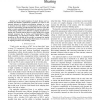Free Online Productivity Tools
i2Speak
i2Symbol
i2OCR
iTex2Img
iWeb2Print
iWeb2Shot
i2Type
iPdf2Split
iPdf2Merge
i2Bopomofo
i2Arabic
i2Style
i2Image
i2PDF
iLatex2Rtf
Sci2ools
131
Voted
INFOCOM
2012
IEEE
2012
IEEE
Truthful prioritization schemes for spectrum sharing
Abstract—As the rapid expansion of smart phones and associated data-intensive applications continues, we expect to see renewed interest in dynamic prioritization schemes as a way to increase the total utility of a heterogeneous user base, with each user experiencing variable demand and value for access. We adapt a recent sampled-based mechanism for resource allocation to this setting, which is more effective in aligning incentives in a setting with variable demand than an earlier method for pricing network resources due to Varian and Mackie-Mason (1994). Complementing our theoretical analysis, which also considers incentives on the sell-side of the market, we present the results of a simulation study, confirming the effectiveness of our protocol in aligning incentives and boosting welfare.
| Added | 28 Sep 2012 |
| Updated | 28 Sep 2012 |
| Type | Journal |
| Year | 2012 |
| Where | INFOCOM |
| Authors | Victor Shnayder, Jeremy Hoon, David C. Parkes, Vikas Kawadia |
Comments (0)

